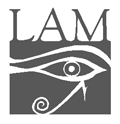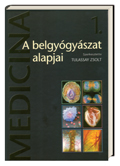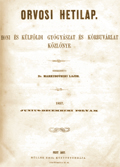The eLitMed.hu medical portal uses computer cookies for convenient operation. Detailed information can be found in the Cookie-policy.
Lege Artis Medicinae - 2007;17(04-05)
Content
[NSAID-ASSOCIATED GASTROPATHY: RECENT ASPECTS OF PREVENTION]
[Nonsteroidal anti-inflammatory drugs (NSAIDs) are among the most widely used drugs worldwide. Gastroduodenal ulcers are found at endoscopy in 15 to 30% of patients who use NSAIDs regularly. The annual incidence of severe upper gastrointestinal complications such as bleeding or perforation is 1.0 to 1.5%. From a cost-benefit perspective, prevention strategies should consider both gastrointestinal, and recently, cardiovascular risk factors. No prophylaxis is necessary with low gastrointestinal risk. There are currently four possible strategies to reduce the risk of adverse gastrointestinal effects: 1. the use of selective COX-2 inhibitors or coxibs rather than traditional NSAIDs; 2. cotherapy, primarily with proton pump inhibitors, to ensure protection to gastric mucous membrane; 3. co-therapy with a coxib and a proton pump inhibitor in patients with very high risk (eg., history of bleeding); 4. eradication of Helicobacter pylori infection in patients with a history of ulcer. The use of coxibs decrease the risk of gastrointestinal damage by roughly 50%. In the presence of gastrointestinal risk factors or for patients on aspirin also treated with an NSAID or a coxib, protection with a proton pump inhibitor is recommended. Proton pump inhibitor therapy is also useful for the prevention and treatment of NSAID-induced dyspepsia. The beneficial effects of proton pump inhibitors cannot solely be explained by their profound antisecretory action. Therefore, several acid secretion- independent mechanisms of action have been proposed.]
[SERUM ALANIN AMINOTRANSFERASE VALUES AND CHRONIC HEPATITIS C - HOW MUCH IS “NORMAL”, AND WHO SHOULD BE TREATED?]
[Serum aminotransferases (= transaminases), especially alanin aminotransferase have been used in the diagnosis of liver diseases, including viral hepatitis, for decades. However, reliability of these biochemical markers was challenged in various respects by recent clinical studies. First, it has been shown not to be sensitive enough in screening for viral hepatitis in high risk populations (viral hepatitis may be present with normal values). Second, normal range is exceeded in a large number of subjects without genuine liver disease due to the increased proportion of people with metabolic disease (diabetes, dyslipidaemia) or high body weight, i.e., the upper limit of normal is too strict. Moreover, decision on treatment of patients with viral hepatitis infection and persistently normal aminotransferases poses a challenge for the clinician. Based on the current literature, this review attempts to provide guidelines for the everyday clinical practice.]
[MANAGEMENT OF GASTROINTESTINAL DISEASES DURING PREGNANCY]
[Medical treatment of gastrointestinal diseases has developed dramatically in the past 10 years. However, management of gastrointestinal disorders in pregnancy is still a serious challenge and requires special expertise. This paper provides recommendations on the indications of gastrointestinal endoscopy and treatment options based on the best available evidence, primarily from large retrospective studies and case reports. Currently there are no generally applicable, widely accepted, evidence-based guidelines available on the treatment of pregnant women. The risks of the gastrointestinal disease versus those of the medications used to treat it should be considered with regard to the health of both the mother and the foetus in each individual case. The risks and benefits of treatment and the consequences of withholding treatment should be discussed with the patient, the obstetrician and any other clinicians involved, and should be carefully documented.]
[THE PATHOBIOLOGICAL BASES OF CANCER]
[This communication intends to give an overview of the cell biological changes that maintain the underlying pathobiological events (invasive growth, metastasis formation, angiogenesis) of tumour progression. The multiple and continuously accumulating mutations of the cells affected by the etiological factors are collectively termed the malignant genotype of the tumour cells, which varies greatly on one hand, but, on the other hand, they are invariably related to an increased survival potential or invasive growth. Properties of the tumour cells produced by the malignant genotype, including immortalization, reduced apoptosis, uncontrolled proliferation, adaptation to hypoxia, resistance, metastatic potency and production of biopolymers harmful to the body are collectively termed the malignant phenotype. The malignant phenotype shows a remarkable variance among the tumours, also, certain forms are present in all stages, while others only appear in specific stages of tumour progression. Consequently, beside clinico-pathological examinations, the identification of the underlying malignant phenotype in each tumour allows a better prediction of tumour progression and a targeted planning of therapy.]
[ERDHEIM-CHESTER DISEASE: A RARE FORM OF HISTIOCYTOSIS]
[INTRODUCTION - Erdheim-Chester disease is rare non-Langerhans cell histiocytosis with multisystem involvement. The histological hallmark of the disease is CD1a negative histiocyte proliferation. CASE REPORT - Histiocytosis presented in a 57- year-old Caucasian man with exophtalmus, which was after two years followed by progressive pericardial infiltration and effusion leading to cardiac compression and consequent functional disturbance. It was the histological analysis of a surgical sample removed during pericardial fenestration that revealed Erdheim- Chester disease. The patient died from multisystem involvement one year after the initial diagnosis. Postmortem examination showed long bone, orbital cavity and cranial cavity involvement as well as extensive retroperitoneal and mediastinal xanthogranulomatous infiltration. CONCLUSIONS - The clinical diagnosis of Erdheim-Chester disease is difficult because the symptoms are insidious and non-specific. The histological report is often only descriptive. The prognosis of the disease is poor due to the lack of targeted therapy and to the advanced stage at diagnosis.]
[SEVERE GASTROINTESTINAL AND RENAL MANIFESTATIONS OF HENOCH-SCHÖNLEIN PURPURA]
[INTRODUCTION - Henoch-Schönlein purpura is a systemic small vessel vasculitis characterized by vascular and/or mesangial IgA deposits, primarily affecting the vasculature of the skin, joints, kidneys and gastrointestinal tract. Gastrointestinal findings of various severity occur in 50 to 85% of the cases. We report on a 70-year-old woman who developed ileocaecal invagination and upper gastrointestinal haemorrhage as manifestations of Henoch-Schönlein purpura. CASE REPORT - The patient presented with two days history of palpable purpuric rash localized on the lower extremities. Based on the result of the skin biopsy, which showed leukocytoclastic vasculitis, IgA and C3 deposits, Henoch-Schönlein purpura was suspected. On the second night after admission colicky abdominal pain, vomiting and diarrhoea developed. Radiological examination showed an ileocaecal invagination and since symptoms deteriorated caecum resection and ileo-ascendestomy was performed. On the third postoperative day the patient became oligo-anuric, which was attributed to her Henoch-Schönlein disease, and systemic steroid pulse therapy was given. One month after the admission the patient experienced haematochezia. Emergency upper endoscopy revealed petechiae, haemorrhagic erosions and mucosal oedema, primarily in the descending part of the duodenum. Since these lesions were also considered as presentations of Henoch-Schönlein disease, another bolus of parenteral steroid was administered. Upper endoscopy repeated 3 days later showed remarkable improvement of the gastric and intestinal lesions. CONCLUSION - Gastrointestinal symptoms are common manifestations of Henoch-Schönlein purpura, thus their recognition, in which endoscopy plays a crucial role, is of major importance. Methylprednisolone pulse therapy is an effective therapeutic option not only in the management of severe renal or joint symptoms, but also in the treatment of gastrointestinal manifestations.]
1.
Clinical Neuroscience
Is there any difference in mortality rates of atrial fibrillation detected before or after ischemic stroke?2.
Clinical Neuroscience
Factors influencing the level of stigma in Parkinson’s disease in western Turkey3.
Clinical Neuroscience
Neuropathic pain and mood disorders in earthquake survivors with peripheral nerve injuries4.
Journal of Nursing Theory and Practice
[Correlations of Sarcopenia, Frailty, Falls and Social Isolation – A Literature Review in the Light of Swedish Statistics]5.
Clinical Neuroscience
[Comparison of pain intensity measurements among patients with low-back pain]1.
Clinical Neuroscience Proceedings
[A Magyar Stroke Társaság XVIII. Kongresszusa és a Magyar Neuroszonológiai Társaság XV. Konferenciája. Absztraktfüzet]2.
3.
Journal of Nursing Theory and Practice
[A selection of the entries submitted to the literary contest "Honorable mission: the joys and challenges of our profession" ]4.
Journal of Nursing Theory and Practice
[End of Life and Palliative Care of Newborns in the Nursing Context]5.
Journal of Nursing Theory and Practice
[Aspects of Occupational Health Nursing for Incurable Patients ]































